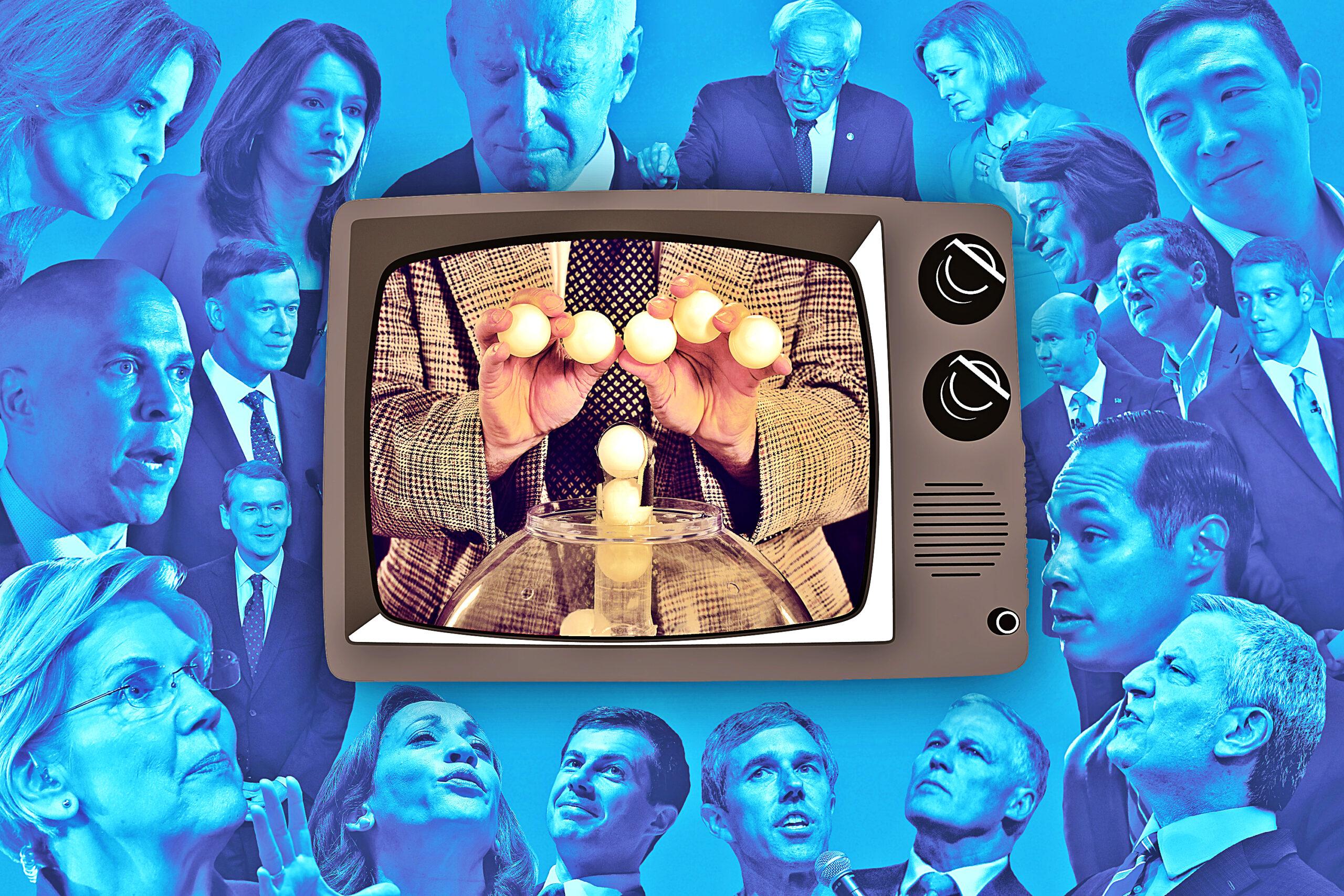
Once upon a time, politics were boring, or so they say. Now, friends and countrymen, they are anything but, and getting less so by the day. On this day, the progressive de-boring-ing is particularly evident, because we are about to witness history: On Thursday at 8 p.m. ET, otherwise known as prime time, CNN will air the first-ever live debate draft.
We don’t know exactly what the draft will entail—probably not ping-pong balls, though a CNN spokesperson did not respond to a request for more information. But we do know that the 20 candidates who qualified for the second Democratic presidential primary debate later this month will be divvied up at random between the event’s two scheduled nights, based on three tiers that can be thought of roughly as front-runners, possibilities, and long shots, scattering an equal number of each on either evening. We, the people, and she, the senator from Massachusetts, and he, the former vice president, and she, the senator from California, and also she, the not-a-guru, all wait with bated breath. It is an event to determine another event to determine … the president of the United States, maybe?
“This CNN ‘draft’ feels like something akin to the NBA draft lottery or the release of the NCAA tournament bracket,” says Kyle Kondik, who serves as managing editor of Sabato’s Crystal Ball at the University of Virginia Center for Politics. Which makes a kind of sense, he says: “Both politics and sports have long seasons, voluminous statistics, and, most importantly, quantifiable winners and losers.”
But we don’t typically see politics eventized to quite this degree. “I understand the impulse to create interest and drama and attention, to drive viewership to the event,” says Mark Lukasiewicz, the dean of the Lawrence Herbert School of Communication at Hofstra University. “But I think it contributes to an overall gamification of the primary debate process, and I don’t think that’s ultimately a positive. I think it’s a serious thing to bring these candidates together and introduce them to the country, in many ways for the first time, and I’m not sure a lotto determining who goes on what night or who stands in what place is the best way to do that.”
Lukasiewicz should know: He previously served as senior vice president of special events at NBC, where he produced numerous presidential debates and forums, and he acknowledges the show-business element inherent to television journalism. But this, he says, goes far beyond a ceremonial coin toss. “I think—and I take my share of the blame because I produced many of these things myself—that over time the balance has tipped too far in the direction of show business and entertainment. The production values that are brought to these events increasingly resemble major live entertainment events: the raucous live audience, the music, the graphics. Those are all things that help attract a television audience, but I think in some ways they take away from the emphasis on the candidates and especially on the policies of the candidates.”
The dispersal of candidates between the two nights, of course, is not unimportant. Will we see former vice president Joe Biden and California Senator Kamala Harris face off again? Will Massachusetts Senator Elizabeth Warren finally get her own shot at Biden? Can former Texas representative Beto O’Rourke pull out of a tailspin that saw a dismal quarter of fundraising? Can South Bend Mayor Pete Buttigieg solidify his place among the race’s heavy hitters? For the less widely known candidates, this second debate is a last, best chance to stay in the race: The third debate, scheduled for September, has prohibitively steep requirements to make the stage, meaning that the field will almost certainly winnow substantially—unless those polling in the 1 percent range are able to capitalize on this moment in the national spotlight to finally woo a larger number of supporters (and, ahem, donors). But while NBC, which aired the first debate last month, opted to conduct its own drawing for the two-night debate split off the air, and in the presence only of representatives from the campaigns, CNN has turned the event into a spectacle that will see some of the network’s marquee anchors, including Wolf Blitzer and Anderson Cooper, on hand to break down the results in real time—a sort of election night, lite.
That such a division is necessary at all was a choice made by the Democratic National Committee, the party’s governing body, not CNN. In the 2016 Republican primary, the Republican National Committee, facing a similarly unwieldy group of hopefuls, placed the 10 highest-polling candidates onstage for a two-hour prime-time debate, with seven lower-polling candidates reduced to a one-hour debate earlier in the day. But last year, DNC chairman Tom Perez said that the Democrats would avoid pushing lower-polling candidates to an “undercard” debate in the hope that “everyone feels their candidate got a fair shot,” as he put it—and that, perhaps, those who back a losing candidate would not feel that the eventual nominee had the party putting a thumb on the scale, as some Bernie Sanders supporters alleged with Hillary Clinton in the 2016 race.
To some degree, UVA’s Kondik says, all of this is new: Back-to-back debates are new, as was, in 2016, the Republican undercard debate. These inventions owe less, perhaps, to the whims of a party or television, and more to the new reality of national politics: “Primary debates themselves go back decades, but they really have only come to predominate over the past few decades.”
Still, says Kondik: “Politics has seen its fair share of gimmicks over the years, but this is a new one as far as I can remember.”

